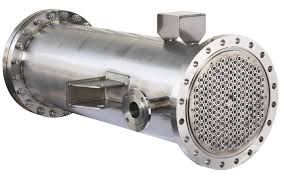Introduction
Desalination heat exchangers is a specialized device used to transfer heat between fluids during the desalination of seawater or brackish water. It plays a crucial role in energy recovery by capturing heat from hot streams (like brine or steam) and using it to preheat incoming cold seawater. This process significantly improves the thermal efficiency of the system and reduces the energy footprint of water production. Since desalination is often energy-intensive, these heat exchangers are vital in making the process more cost-effective and environmentally sustainable.
Purpose and Functionality:
Desalination processes, especially thermal-based ones, require large amounts of heat to evaporate water from saline sources. However, a lot of heat is typically lost in the outgoing brine. The main purpose of a heat exchanger in this setup is to recover and reuse that thermal energy.
Key Functions:
- Preheat cold seawater using residual heat from outgoing brine or condensate.
- Reduce the demand for external heating sources like boilers or heaters.
- Minimize thermal losses, improving the energy economy of the desalination system.
- Enable energy recovery cycles, especially in closed-loop or multi-stage systems.
By doing so, heat exchangers make the process more sustainable and help lower operational costs.
Common Types of Heat Exchangers Used in Desalination:
Shell and Tube Heat Exchangers:
- Consist of a bundle of tubes enclosed in a cylindrical shell.
- One fluid flows inside the tubes, while the other flows outside the tubes but within the shell.
- Suitable for large-capacity thermal desalination plants like MSF (Multi-Stage Flash) or MED (Multi-Effect Distillation).
- Known for durability, high-pressure handling, and good heat transfer rates.
- Can be configured in single or multiple passes for complex heat exchange requirements.
Plate Heat Exchangers:
- Made of multiple thin, corrugated metal plates stacked closely together.
- Fluids flow in alternate channels created by the plates, ensuring large surface area for heat transfer.
- Highly efficient in compact spaces, making them suitable for modular RO systems or small-scale thermal units.
- Easier to disassemble, clean, and maintain compared to shell and tube types.
- Typically used when space and maintenance access are critical considerations.
Materials – Titanium and Cupronickel:
Due to constant contact with seawater, these heat exchangers require materials with high corrosion resistance.
- Titanium:
- Immune to corrosion from seawater and chemicals.
- Excellent strength-to-weight ratio and long service life.
- Though expensive, it ensures long-term reliability and low maintenance.
- Cupronickel (90/10 or 70/30):
- Resistant to both corrosion and biofouling.
- More cost-effective than titanium but suitable for mild to moderate seawater environments.
- Commonly used in tube bundles of shell and tube exchangers.
Applications in Different Desalination Processes:
Thermal Desalination (MSF and MED):
These systems use heat to evaporate seawater and condense the vapor into freshwater.
- Multi-Stage Flash (MSF):
- Heat exchangers are used in each stage to preheat seawater before entering the flash chamber.
- Also recover heat from the hot brine and condensate, increasing cycle efficiency.
- Multi-Effect Distillation (MED):
- Heat exchangers transfer latent heat between multiple effects or stages.
- Vapor from one stage heats seawater in the next, and heat exchangers are key to this inter-stage heat reuse.
Reverse Osmosis (RO):
Although RO is not heat-based, heat exchangers still play a role in:
- Preheating feedwater for better membrane performance in cold climates.
- Used in energy recovery devices (like isobaric chambers or pressure exchangers) where pressure energy is transferred from brine to incoming seawater.
- In hybrid desalination plants, they support both RO and thermal operations by optimizing temperature and energy flow.
Key Features of Desalination Heat Exchangers:
Corrosion-Resistant Materials:
- Continuous exposure to salt and chlorides requires materials that can withstand corrosion, pitting, and scaling.
- Common materials: Titanium, Cu-Ni, Super Duplex Stainless Steel.
- Prevents premature failure and ensures long-term reliability in marine environments.
High Thermal Efficiency:
- Maximized surface area in compact forms allows for efficient heat transfer between fluids.
- Reduces thermal loss, improving the energy performance of the entire desalination system.
- Plate heat exchangers often reach efficiencies above 90% in ideal conditions.
Ease of Maintenance and Cleaning:
- Marine biofouling (algae, barnacles) and scaling (mineral deposits) are common issues.
- Designs like removable tube bundles or gasketed plates allow for easy access and cleaning.
- Mechanical cleaning, chemical cleaning, or high-pressure water jets can be used depending on the fouling type.
Supports Energy Recovery:
- Integral to energy recovery loops, especially in multi-effect thermal desalination.
- Reduces external fuel usage, making desalination more affordable and environmentally friendly.
- Often paired with thermal vapor compressors, condensers, or steam ejectors for optimized performance.
Additional Considerations:
- Design Considerations:
- Flow configuration (counter-current or co-current)
- Pressure drop, fouling factors, maintenance intervals
- Size, material, cost balance
- Environmental Impact:
- Heat exchangers help reduce energy use and greenhouse gas emissions.
- Supports sustainable desalination, essential for coastal regions facing water scarcity.
- Emerging Trends:
- Use of nanocoatings and anti-fouling surfaces for improved performance.
- Hybrid heat exchangers combining thermal and pressure recovery in next-gen desalination plants.
Conclusion
Desalination heat exchangers are indispensable components in both thermal and membrane-based desalination systems. They significantly enhance energy efficiency by recovering and reusing heat, reducing operational costs, and ensuring sustainable water production. With the ability to withstand harsh marine environments and operate under high temperatures and pressures, these heat exchangers contribute to the reliability and longevity of desalination plants. Choosing the right type—be it shell and tube or plate—and using the appropriate materials like titanium or cupronickel ensures optimal performance tailored to specific process requirements.

